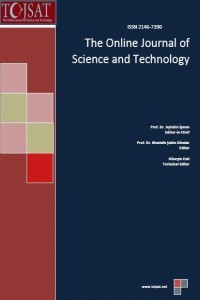ANTIMICROBIAL AND ANTIOXIDANT ACTIVITIES OF THAI LOCAL FRUIT EXTRACTS: APPLICATION OF A SELECTED FRUIT EXTRACT, PHYLLANTHUS EMBLICA LINN. AS A NATURAL PRESERVATIVE IN RAW GROUND PORK DURING REFRIGERATED STORAGE
ANTIMICROBIAL AND ANTIOXIDANT ACTIVITIES OF THAI LOCAL FRUIT EXTRACTS: APPLICATION OF A SELECTED FRUIT EXTRACT, PHYLLANTHUS EMBLICA LINN. AS A NATURAL PRESERVATIVE IN RAW GROUND PORK DURING REFRIGERATED STORAGE
fruit extract, Phyllanthus emblica, antimicrobial, antioxidant,
___
- Ahmad, S. –A., Catalano, S., Marsili, A., Morelli, I., & Scartoni, V. (1977). Chemical examination of leaves of Ardisia solanacea. Planta Medica, 32, 162-164.
- Brand-Williams, W., Cuvelier, M., & Bersert, E. C. (1995). Use of a free radical method to evaluate antioxidant activity. Lebensmittle Wissenschaft and Technologie, 28, 25-30.
- Blasa, M., Gennari, L., Angelino, D., & Ninfali, P. (2010). Fruit and vegetable antioxidants in health. In R. R. Watson & V. R. Preedy (Eds.), Bioactive foods in promoting health: fruits and vegetables (pp. 37-58). New York: Elsevier Inc.
- Collin, C. H., Lyne, P. M., & Grange, J. M. (2001). Collin and Lyne’s microbiology methods. New York: Oxford University Press Inc.
- Jorgensen, J. H., Turnidge, J. D., & Washington, J. A. (1999). Antibacterial susceptibility test: dilution and disk diffusion methods. In P. R. Murray, E. R. Barron, M. A. Praller, F. C. Tenover & R. H. (Eds.), Manual of clinical microbiology (pp. 1526-1562). Washington, DC: ASM Press.
- Kirk, R. S., & Sawyer, R. (1991). Pearson’s composition and analysis of foods. Essex: Longman Scientific & Technical.
- Lado, C., Then, M., Varga, I., Szőke, É., & Szentmihályi, K. (2004). Antioxidant property of volatile oils determined by the ferric reducing ability. Z. Naturforsch, 56c, 354-358.
- Luo, W., Zhao, M., Yang, B., Shen, G., & Rao, G. (2009). Identification of bioactive compounds in Phyllanthus emblica L. fruit and their free radical scavenging activities. Food Chemistry, 114, 499-504.
- Mayachiew, P., & Devahastin, S. (2008). Antimicrobial and antioxidant activities of Indian gooseberry and galangal extracts. Lebensmittle Wissenschaft and Technologie, 42, 1153-1159.
- Mehmood, M. H., Siddigi, H. S., & Gilani, A. H. (2011). The antidiarrheal and spasmolytic activities of Phyllanthus emblica are mediated through dual blockade of muscarinic receptor and ca2+ channels. Journal of Ethnopharmacology, 133, 856- 865.
- Pinsuwan, S., Ingkatawornwong, S., Kaewoan, P., Sakdisate, P., & Sukaphat, N. (Eds.). (2007). Development of liposomes containing Phyllanthus emblica extract. Proceedings from The 33rd Congress on Science and Technology of Thailand. Walailak University, Nakhon Si Thammarat, Thailand.
- Roessler, E. B., Panborn, R. M., Sidel, J. L., & Stone, H. (1978). Expand statistical table for estimating significance in paired – preference, paired – difference, duo – trio and triangle tests. Journal of Food Science, 43, 940 – 943.
- Ruangchakpet, A., & Sajjaanantakul, T. (2007). Effect of Spanish plum (Elaeocarpus hygrophilus Kurz.) maturity on tota phenolics, flavonoids and antioxidant activity. Agricultural Science Journal, 38, 127-130.
- Samee, W., Engkalohakul, M., Nebbua, N., & Direkrojanavuti, P. (2006). Correlation analysis between total acid, total phenolic and ascorbic acid contents in fruit extracts and their antioxidant activities. Thai Pharmaceutical and Health Science Journal, 1, 196-203.
- Suntornsuk, L., Gritsanapun, W., Nilkamhank, S., & Paochom, A. (2002). Quantitation of vitamin C content in herbal juice using direct titration. Journal of Pharmaceutical Biomedical Analysis, 28, 849-855.
- Tepe, B., Daferera, D., Sokmen, A., Sokmen, M., & Polissiou, M. (2005). Antimicrobial and antioxidant activities of the essential oil and various extracts of Salvia tomentosa Miller (Lamiaceae). Food Chemistry, 90, 333-340.
- Lim, Y. Y., Lim, T. T., & Tee, J. J. (2007). Antioxidant properties of several tropical fruits: A comparative study. Food Chemistry, 103, 1003-1008.
- ISSN: 2146-7390
- Başlangıç: 2011
- Yayıncı: The association of science, education and technology
SMALL ROV TO DETECTION AND IDENTIFICATION OF DANGEROUS UNDERWATER OBJECTS
Jerzy Garus, Agnieszka Studanska
THE CHEMICAL INVESTIGATION ON WATER POLLUTION OF KURNOOL DISTRICT BY WATER QUALITY ANALYSIS
Mohemmad Rafi K., Ramachar T., Umamahesh M.
Oluwole Abimbola, Tyler Bowling, Bahadir Edizer, Heather Kunze, John Thistlethwaite
TRAFFIC POLLUTANTS LEVELS AT DIFFERENT DESIGNS OF KING FAHD ROAD, SAUDI ARABIA: COMPARATIVE STUDY
Mahmoud F. El-Sharkawy, Gehan R. Zaki
Mohamed Sifour, Idoui Tayeb, Houria Ouled Haddar, Heba Namous, Salima Aissaoui
BIODEGRADATION OF PESTICIDE: BROMUCONAZOL BY MICROBIAL CONSORTIUM IN BIPHASIC SYSTEM
Ouahiba BORDJIBA, Nouha OUARTSI, Ryad DJERIBI
CHEMICAL MODIFICATION OF WATER HYACINTH FOR THE REMOVAL OF DYESTUFFS
Winai Somboon, Vanida Bhavakul, Suntud Sirianuntapiboon
Houria Ouled-Haddar, Tayeb Idoui, Mohamed Sifour, Messaouda Guezira, Messaouda Bouthabet
A CFD MODEL FOR SIMULATING URBAN FLOW IN COMPLEX MORPHOLOGICAL STREET NETWORK
Saddok Houda, Noureddine Zemmouri, Abdelmalek Hasseine, Rachid Athmani, Rafik Belarbi
COSMETIC FORMULATIONS CONTAINING BLUEBERRY EXTRACTS (VACCINIUM MYRTILLUS L.)
